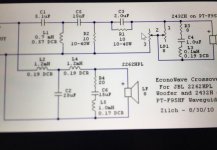If you use RLC to flatten the impedance peak, then this is independent of the crossover. If you do it right, then you do it once, you can change the crossover and pay no attention to it. Because it makes the impedance look like a resistor, it does not react with the crossover.
Hi Allen. When I choose a woofer which is more than 6dB below my tweeters efficiency, how
do I calculate this. In your tutorial it goes up to a difference of 6dB.
For instance when the difference is 8dB do I multiply the tweeter's impedance value by
1.4 ? Or do I have to choose different drivers.
do I calculate this. In your tutorial it goes up to a difference of 6dB.
For instance when the difference is 8dB do I multiply the tweeter's impedance value by
1.4 ? Or do I have to choose different drivers.
Thanks Allen.
One question about an L-pad. Do I skip the the 10 or 20 ohm resistor from your tutorial and
just use the L-pad.?
The tweeter I want to use is a 6 ohm tweeter and with a 10 ohm resistor it will give me
3.75 ohm which I also use in calculating the second order crossover on the tweeter.
Now are these L-pad calculators designed to keep the tweeter at 6 ohm, or will it change the
tweeters impedance?
One question about an L-pad. Do I skip the the 10 or 20 ohm resistor from your tutorial and
just use the L-pad.?
The tweeter I want to use is a 6 ohm tweeter and with a 10 ohm resistor it will give me
3.75 ohm which I also use in calculating the second order crossover on the tweeter.
Now are these L-pad calculators designed to keep the tweeter at 6 ohm, or will it change the
tweeters impedance?
- Home
- Loudspeakers
- Multi-Way
- Introduction to designing crossovers without measurement
